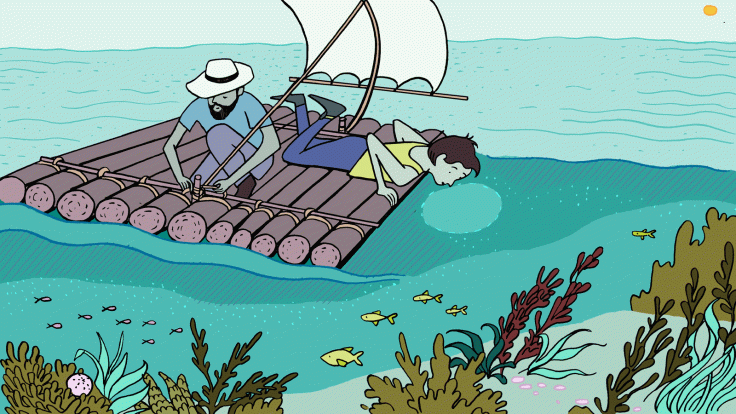Science: A Richer Experience of Life
by Mike Perricone
Michael Salamon brings an outward vision to Office of Science and Technology Policy.
When I heard the learn'd astronomer;
When the proofs, the figures, were ranged in columns before me;
When I was shown the charts and the diagrams, to add, divide, and measure them;
When I, sitting, heard the astronomer, where he lectured with much applause in the lecture-room,
How soon, unaccountable, I became tired and sick;
Till rising and gliding out, I wander'd off by myself,
In the mystical moist night-air, and from time to time,
Look'd up in perfect silence at the stars.
Walt Whitman
"When I heard the Learn'd Astronomer," Leaves of Grass

Photo: Maggie Draughon
Michael Salamon says Walt Whitman got it wrong: the more one learns about nature, the more beautiful it becomes.
"The poet describes his sense of ennui over what he sees as an objectification, a de-beautifying of the sky and stars," says Salamon, the new Assistant Director for the Physical Sciences in the Science Division of the White House Office of Science and Technology Policy (OSTP). "Then the poet goes outside, looks up and has a sort of mystical communion. But does science really de-beautify nature? What I've always believed is that when you have a better understanding of nature, what you see is a much deeper level of beauty and esthetics. You're privileged with a much richer experience of being alive. This is what I've always told my students."
While their early observations came nearly a century apart, Salamon and Whitman both drew inspiration from the sky over Brooklyn, New York. Whitman lived in Brooklyn much of his life. Salamon, 54, was born and raised there in the epic era of Sputnik and the space race, departing for the Massachusetts Institute of Technology at age 17 to follow his own stars. Graduate and postdoctoral work with an astrophysics group at the University of California, Berkeley, led to a faculty position at the University of Utah in 1988, where he worked in both theoretical and experimental astrophysics for 14 years, concentrating in high-energy particle physics and gamma-ray astrophysics.
But 1989 brought a detour into an international imbroglio. That year at Utah, Stanley Pons and Martin Fleischmann reported startling cold fusion results: energy production from a nuclear fusion process without extreme temperatures or pressures. Salamon—still a relatively recent arrival—was asked by his university administration to independently verify particle emission from Pons' heat-generating cells.
"Essentially, no one in the physics department was aware this result was coming," Salamon says, rueful of recreating the circumstances. "We didn't have access to Pons's paper, which everyone thought the department had vetted. I and a few other members of the department were able to get Pons in his office and read the paper while he was watching us, so no one could make a copy. I had done a lot of work with particle detectors and particle-detector technology, and I immediately saw just by the shape of the gamma-ray spectrum that his claims of gamma rays and neutron detection were incorrect. I pointed that out the next day to the university president. He asked me if I would be willing to go into Pons's lab to verify nuclear emissions. I monitored radiation in Pons' lab independently for five to six weeks, after which I was asked to leave. I wrote a paper with several colleagues on our negative results that was published in Nature, placing limits that were orders of magnitude below what [Pons] had claimed."
The scientific community erupted with charges, countercharges, retractions, and threats of lawsuits and countersuits, before resuming its steady state. Salamon started giving talks on "the nuclear physics/litigation interface."
Salamon moved on to NASA in 2001 as Discipline Scientist for Fundamental Physics in the Universe Division, Science Mission Directorate. Functionally, he directed the Theoretical Astrophysics program and was the program scientist for several significant projects: The Laser Interferometer Space Antenna (LISA), the Wilkinson Microwave Anisotropy Probe (WMAP), Gravity Probe B, the Planck Mission, and the Joint Dark Energy Mission (JDEM), a project of NASA and the US Department of Energy. "I've learned quite a bit about what makes a mission work and not work," Salamon says. "It's been an interesting and educational experience."
NASA is now "detailing" Salamon to OSTP, for one to three years. Congress established OSTP in 1976 to advise the President on the impacts of science and technology in domestic and international affairs. Salamon's role is to help "inform the policy decision-making process," as his predecessor, Patrick Looney, has described it. Formerly at the National Institute of Standards and Technology, Looney is now moving to Brookhaven National Laboratory. "These are big shoes to fill," Salamon says, "but it's an exciting opportunity with very interesting challenges."
Moving into his new office on his second day at OSTP left Salamon without time or space for conjecture over policy issues looming in particle physics. But some of his earlier work—searches for magnetic monopoles and for antimatter abundance in cosmic rays—has been at the interface of cosmology and particle physics, and he relishes the mysteries ahead.
"We're exploring the dimensionality of spacetime itself: Every person in the world should be excited about that," Michael Salamon says. "What is dark energy? What is the vacuum? What is responsible for baryogenesis? Are we close to finding supersymmetry? We live in a very, very exciting time. As one of my colleagues says, this is a good time to be alive."
Click here to download the pdf version of this article.






